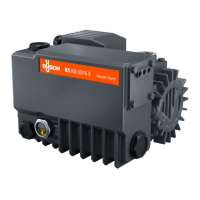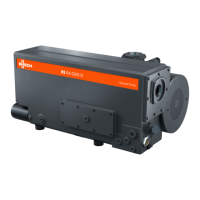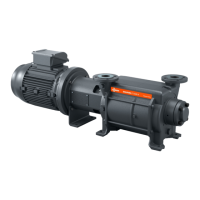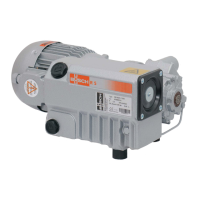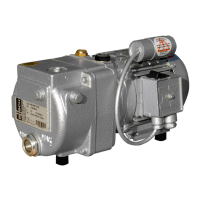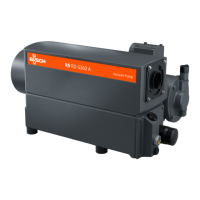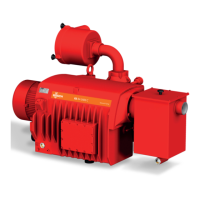3
1.4 Vacuum Connections and Drip Legs
Use a line size to the vacuum system that is at least as
large as that of the pump inlet. Smaller lines will result
in lower pumping speeds than the rated values.
Install a drip leg and drain on the vertical pipe near the
pump inlet. Also, when installing discharge piping, a
drip leg should be installed. Drain the drip legs often to
remove any condensation which may have collected.
If more than one vacuum pump or a receiver tank is
connected to a common main line, each pump should
have its own manual or automatic operated shut-off
valve or positive action check valve. The built-in, anti-
suck-back valve should not be used as a shut-off valve
for the vacuum system.
Remove the plastic protective cap from the inlet port
prior to connection of the pump to the system. Vertical
connection of the vacuum line can be made directly to
the pump inlet (Ref. 260).
Type and size of the inlet connections of the R 5 Series
pumps are shown in the TECHNICAL DATA page 14.
If the gas that is pumped contains dust or other foreign
solid particles, a suitable inlet filter (10 micron rating or
less) should be connected to the inlet port. Consult the
factory for recommendations.
1.5 Oil Filling
The pump is shipped without oil. After level installation,
and after correct rotation has been established and with
the pump switched "off" and secured against accidental
start-up, fill the pump with the recommended vacuum
oil through the oil filling port (Ref. 88), observing the
"MAX" and "MIN" position at the oil sight glass (Ref.
83).
CAUTION: The built-in, anti-suck-back valve
is not positive action; do not use it as a sys-
tem check valve.
Exhaust
Inlet
Exhaust filter
Gas ballast
(RA)
Rotor
Anti-suckback valve
Inlet screen
Vane
Automotive type
spin-on filter
Main oil feed line
Exhaust valve (RA)
Oil return valve (RA)
Oil sight glass
Oil return line to
inlet (RC)
Fig. 1 - Basic R 5 Pump
CAUTION: After the electrical connection
has been made, but before the pump is
filled with oil, the rotation of the motor
must be checked. Open the inlet port and
jog the motor briefly to make sure rotation
is correct. If it runs backwards and if it is
wired three phase power, reverse any two
leads of the three at the power connection.

